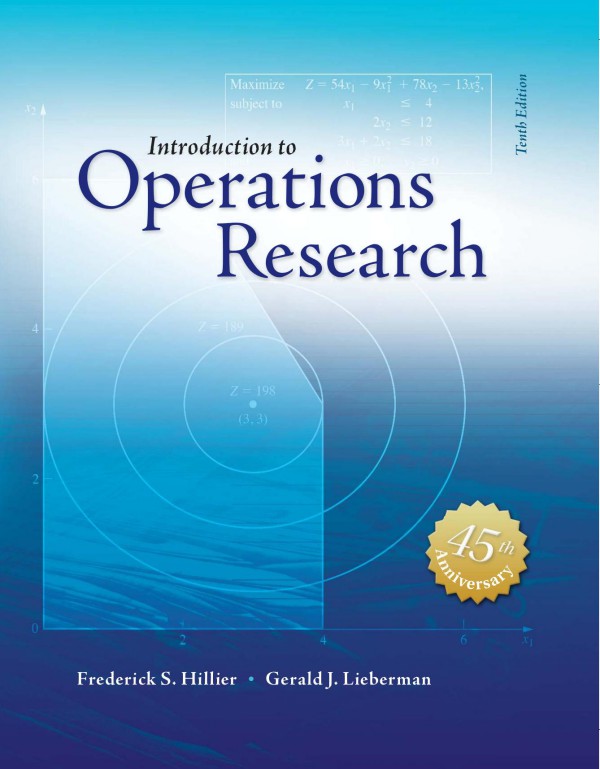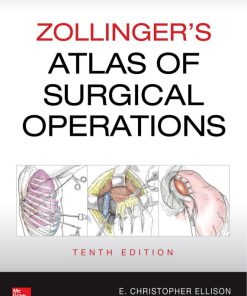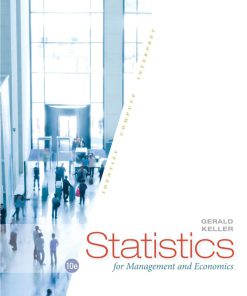Introduction to Operations Research 10th Edition by FREDERICK HILLIER, GERALD LIEBERMAN ISBN 0073523453 9780073523453
$50.00 Original price was: $50.00.$25.00Current price is: $25.00.
Authors:Frederick S. Hillier; Gerald J. Lieberman , Series:IT & Computer [158] , Tags:Computer Engineering; Information Technology , Author sort:Hillier, Frederick S. & Lieberman, Gerald J. , Ids:Google; 9780071181631 , Languages:Languages:eng , Published:Published:Mar 2001 , Publisher:Mcgraw-hill , Comments:Comments:CD-ROM contains: Student version of MPL Modeling System and its solver CPLEX — MPL tutorial — Examples from the text modeled in MPL — Examples from the text modeled in LINGO/LINDO — Tutorial software — Excel add-ins: TreePlan, SensIt, RiskSim, and Premium Solver — Excel spreadsheet formulations and templates.
Introduction to Operations Research 10th Edition by FREDERICK HILLIER, GERALD LIEBERMAN – Ebook PDF Instant Download/Delivery. 0073523453 ,9780073523453
Full download Introduction to Operations Research 10th Edition after payment
Product details:
ISBN 10: 0073523453
ISBN 13: 9780073523453
Author: FREDERICK HILLIER, GERALD LIEBERMAN
Introduction to Operations Research 10th Edition Table of contents:
CHAPTER 1: Introduction
- 1.1 The Origins of Operations Research
- 1.2 The Nature of Operations Research
- 1.3 The Rise of Analytics Together with Operations Research
- 1.4 The Impact of Operations Research
- 1.5 Algorithms and OR Courseware
- Selected References
- Problems
CHAPTER 2: Overview of the Operations Research Modeling Approach
- 2.1 Defining the Problem and Gathering Data
- 2.2 Formulating a Mathematical Model
- 2.3 Deriving Solutions from the Model
- 2.4 Testing the Model
- 2.5 Preparing to Apply the Model
- 2.6 Implementation
- 2.7 Conclusions
- Selected References
- Problems
CHAPTER 3: Introduction to Linear Programming
- 3.1 Prototype Example
- 3.2 The Linear Programming Model
- 3.3 Assumptions of Linear Programming
- 3.4 Additional Examples
- 3.5 Formulating and Solving Linear Programming Models on a Spreadsheet
- 3.6 Formulating Very Large Linear Programming Models
- 3.7 Conclusions
- Selected References
- Learning Aids for This Chapter on Our Website
- Problems
- Case 3.1 Auto Assembly
- Case 3.2 Cutting Cafeteria Costs
- Case 3.3 Staffing a Call Center
- Case 3.4 Promoting a Breakfast Cereal
CHAPTER 4: Solving Linear Programming Problems: The Simplex Method
- 4.1 The Essence of the Simplex Method
- 4.2 Setting Up the Simplex Method
- 4.3 The Algebra of the Simplex Method
- 4.4 The Simplex Method in Tabular Form
- 4.5 Tie Breaking in the Simplex Method
- 4.6 Adapting to Other Model Forms
- 4.7 Postoptimality Analysis
- 4.8 Computer Implementation
- 4.9 The Interior-Point Approach to Solving Linear Programming Problems
- 4.10 Conclusions
- Appendix 4.1 An Introduction to Using LINDO and LINGO
- Selected References
- Learning Aids for This Chapter on Our Website
- Problems
- Case 4.1 Fabrics and Fall Fashions
- Case 4.2 New Frontiers
- Case 4.3 Assigning Students to Schools
CHAPTER 5: The Theory of the Simplex Method
- 5.1 Foundations of the Simplex Method
- 5.2 The Simplex Method in Matrix Form
- 5.3 A Fundamental Insight
- 5.4 The Revised Simplex Method
- 5.5 Conclusions
- Selected References
- Learning Aids for This Chapter on Our Website
- Problems
CHAPTER 6: Duality Theory
- 6.1 The Essence of Duality Theory
- 6.2 Economic Interpretation of Duality
- 6.3 Primal–Dual Relationships
- 6.4 Adapting to Other Primal Forms
- 6.5 The Role of Duality Theory in Sensitivity Analysis
- 6.6 Conclusions
- Selected References
- Learning Aids for This Chapter on Our Website
- Problems
CHAPTER 7: Linear Programming under Uncertainty
- 7.1 The Essence of Sensitivity Analysis
- 7.2 Applying Sensitivity Analysis
- 7.3 Performing Sensitivity Analysis on a Spreadsheet
- 7.4 Robust Optimization
- 7.5 Chance Constraints
- 7.6 Stochastic Programming with Recourse
- 7.7 Conclusions
- Selected References
- Learning Aids for This Chapter on Our Website
- Problems
- Case 7.1 Controlling Air Pollution
- Case 7.2 Farm Management
- Case 7.3 Assigning Students to Schools, Revisited
- Case 7.4 Writing a Nontechnical Memo
CHAPTER 8: Other Algorithms for Linear Programming
- 8.1 The Dual Simplex Method
- 8.2 Parametric Linear Programming
- 8.3 The Upper Bound Technique
- 8.4 An Interior-Point Algorithm
- 8.5 Conclusions
- Selected References
- Learning Aids for This Chapter on Our Website
- Problems
CHAPTER 9: The Transportation and Assignment Problems
- 9.1 The Transportation Problem
- 9.2 A Streamlined Simplex Method for the Transportation Problem
- 9.3 The Assignment Problem
- 9.4 A Special Algorithm for the Assignment Problem
- 9.5 Conclusions
- Selected References
- Learning Aids for This Chapter on Our Website
- Problems
- Case 9.1 Shipping Wood to Market
- Case 9.2 Continuation of the Texago Case Study
- Case 9.3 Project Pickings
CHAPTER 10: Network Optimization Models
- 10.1 Prototype Example
- 10.2 The Terminology of Networks
- 10.3 The Shortest-Path Problem
- 10.4 The Minimum Spanning Tree Problem
- 10.5 The Maximum Flow Problem
- 10.6 The Minimum Cost Flow Problem
- 10.7 The Network Simplex Method
- 10.8 A Network Model for Optimizing a Project’s Time–Cost Trade-Off
- 10.9 Conclusions
- Selected References
- Learning Aids for This Chapter on Our Website
- Problems
- Case 10.1 Money in Motion
- Case 10.2 Aiding Allies
- Case 10.3 Steps to Success
CHAPTER 11: Dynamic Programming
- 11.1 A Prototype Example for Dynamic Programming
- 11.2 Characteristics of Dynamic Programming Problems
- 11.3 Deterministic Dynamic Programming
- 11.4 Probabilistic Dynamic Programming
- 11.5 Conclusions
- Selected References
- Learning Aids for This Chapter on Our Website
- Problems
CHAPTER 12: Integer Programming
- 12.1 Prototype Example
- 12.2 Some BIP Applications
- 12.3 Innovative Uses of Binary Variables in Model Formulation
- 12.4 Some Formulation Examples
- 12.5 Some Perspectives on Solving Integer Programming Problems
- 12.6 The Branch-and-Bound Technique and Its Application to Binary Integer Programming
- 12.7 A Branch-and-Bound Algorithm for Mixed Integer Programming
- 12.8 The Branch-and-Cut Approach to Solving BIP Problems
- 12.9 The Incorporation of Constraint Programming
- 12.10 Conclusions
- Selected References
- Learning Aids for This Chapter on Our Website
- Problems
- Case 12.1 Capacity Concerns
- Case 12.2 Assigning Art
- Case 12.3 Stocking Sets
- Case 12.4 Assigning Students to Schools, Revisited Again
CHAPTER 13: Nonlinear Programming
- 13.1 Sample Applications
- 13.2 Graphical Illustration of Nonlinear Programming Problems
- 13.3 Types of Nonlinear Programming Problems
- 13.4 One-Variable Unconstrained Optimization
- 13.5 Multivariable Unconstrained Optimization
- 13.6 The Karush-Kuhn-Tucker (KKT) Conditions for Constrained Optimization
- 13.7 Quadratic Programming
- 13.8 Separable Programming
- 13.9 Convex Programming
- 13.10 Nonconvex Programming (with Spreadsheets)
- 13.11 Conclusions
- Selected References
- Learning Aids for This Chapter on Our Website
- Problems
- Case 13.1 Savvy Stock Selection
- Case 13.2 International Investments
- Case 13.3 Promoting a Breakfast Cereal, Revisited
CHAPTER 14: Metaheuristics
- 14.1 The Nature of Metaheuristics
- 14.2 Tabu Search
- 14.3 Simulated Annealing
- 14.4 Genetic Algorithms
- 14.5 Conclusions
- Selected References
- Learning Aids for This Chapter on Our Website
- Problems
CHAPTER 15: Game Theory
- 15.1 The Formulation of Two-Person, Zero-Sum Games
- 15.2 Solving Simple Games—A Prototype Example
- 15.3 Games with Mixed Strategies
- 15.4 Graphical Solution Procedure
- 15.5 Solving by Linear Programming
- 15.6 Extensions
- 15.7 Conclusions
- Selected References
- Learning Aids for This Chapter on Our Website
- Problems
CHAPTER 16: Decision Analysis
- 16.1 A Prototype Example
- 16.2 Decision Making without Experimentation
- 16.3 Decision Making with Experimentation
- 16.4 Decision Trees
- 16.5 Using Spreadsheets to Perform Sensitivity Analysis on Decision Trees
- 16.6 Utility Theory
- 16.7 The Practical Application of Decision Analysis
- 16.8 Conclusions
- Selected References
- Learning Aids for This Chapter on Our Website
- Problems
- Case 16.1 Brainy Business
People also search for Introduction to Operations Research 10th Edition:
introduction to operations research 11th edition
introduction to operations research pdf
introduction to operations research 10th edition
introduction to operations research 11th edition free pdf
You may also like…
eBook PDF
Statistics for Management and Economics 10th Edition by Gerald Keller 1285869648 9781285869643












